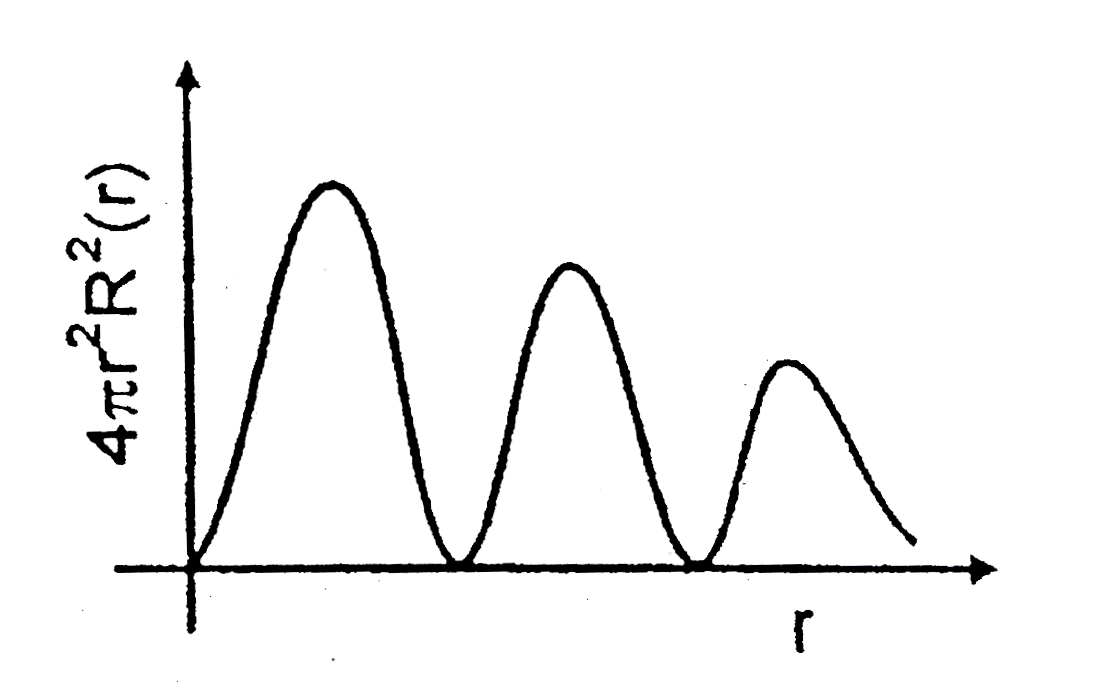For a 3s-orbital
Φ(3s)=1a√3(1a0)3/2(6−6σ+σ2)∈−σ/2
where σ=2rZ3aσ
What is the maximum radial distance of node from nucleus?
23(3+3√3)a0Z
32(3+3√3)a0Z
32(3−3√3)a0Z
32(3−√3)a0Z
The correct Answer is:B
Radial node occurs where probility of finding of e− is zero.
∴Ψ2=0 or Ψ=0∴6−6simga+σ2=0σ=3±√3
For maximum distance r=32(3+3√3)a0Z
Topper's Solved these Questions
- BOOK - RESONANCECHAPTER - NUCLEAR CHEMISTRYEXERCISE - PART-III5videos
NUCLEAR CHEMISTRY
- BOOK - RESONANCECHAPTER - NUCLEAR CHEMISTRYEXERCISE - STAGE-II1videos
NUCLEAR CHEMISTRY
- BOOK - RESONANCECHAPTER - NUCLEAR CHEMISTRYEXERCISE - ADVANCED LEVEL PROBLEMS30videos
NUCLEAR CHEMISTRY
- BOOK - RESONANCECHAPTER - NITROGEN CONTAINING COMPOUNDSEXERCISE - ORGANIC CHEMISTRY(Nitrogen containing Compounds)30videos
NITROGEN CONTAINING COMPOUNDS
- BOOK - RESONANCECHAPTER - P BLOCK ELEMENTSEXERCISE - PART -II24videos
P BLOCK ELEMENTS
Similar Questions
For a 3s - orbital, value of Φ is given by following realation:
Ψ(3s)=19√3(1a0)3/2(6−6σ+σ2)e−σ/2, where σ=2r.Z3a0
What is the maximum radial distance of node from nucleus?View SolutionCalcuted the distance of spherical nodes for '3s' orbital from nucleus ?
R3s=19√3a3/20(6−6σ+σ2)eσ2 Where σ=2rna0View Solution
Knowledge Check
- Question 1 - Select One
According to qauntum mechanical model of H-like species, and electron can be represented by a wave function (ψ) which contain all dynamic information about the electron. The nature of wave function depends on the type of the orbital to which the electron belongs. For an orbital
ψ=[√281√3π](1a0)3/2(27−18σ+2σ2)eσ3
Where, σ=(Zra0),r = radial distance from nucleous, a0=52.9pm
The number of radial and angular nodes possible for the orbital given above are respectivelyAzero,zeroB0,2C2,0D2,1 - Question 2 - Select One
According to qauntum mechanical model of H-like species, and electron can be represented by a wave function (ψ) which contain all dynamic information about the electron. The nature of wave function depends on the type of the orbital to which the electron belongs. For an orbital
ψ=[√281√3π](1a0)3/2(27−18σ+2σ2)eσ3
Where, σ=(Zra0),r = radial distance from nucleous, a0=52.9±
Which of the following represents the position of one of the radial nodes?Ar=12(3+√3)a0Br=12(3−√3)a0Cr=32(3−√6)a0Dr=32(3+√3)a0 - Question 3 - Select One
According to qauntum mechanical model of H-like species, and electron can be represented by a wave function (ψ) which contain all dynamic information about the electron. The nature of wave function depends on the type of the orbital to which the electron belongs. For an orbital
ψ=[√281√3π](1a0)3/2(27−18σ+2σ2)eσ3
Where, σ=(Zra0),r = radial distance from nucleous, a0=52.9±
The orbital could possibly beA4sB4pC3sD3p
For an orbital in B+4 radial function is :
R(r)=19√6(za0)34(4−σ)σe−σ/2
where σ=Zra0 and a0=0.529Å,Z = atomic number, r= radial distance from nucleus.
The radial node of orbital is at distance from nucleous.View SolutionGiven the H−atom Rn,l=19√3(1ao)3/2(6−6σ+σ2)e−σ/2
where σ=2Zrnao,ao=0.53Å
Select the correct statement for the given orbital ?
 View Solution
View SolutionThe Schrodinger wave equation for hydrogen atom of 4s- orbital is given by :
Ψ(r)=116√4(1a0)3/2[(σ2−1)(σ2−8σ+12)]e−σ/2 where a0=1st Bohr radius and σ=2ra0 . The distance from the nucleus where there will be no radial node will be :View SolutionFor H-atom wave function for a particulaonstate is: Ψ=181√3π(1a0)3/2(σ2−10σ+25)e
Where σ=r/a0 and a0 is Bohr's radius (0.53∘A). Then distance of farthest radius mode is approximately.View SolutionThe wave function of 3s and 3pz orbitals are given by :
Ψ3s=19√3(14π)1/2(Zσ0)3/2(6=6σ+σ)e−σ/2
Ψ3sz=19√6(34π)1/2(Zσ0)3/2(4−σ)σe−σ/2cos0,
σ=2Zrnα0
whereα0=1st Bohr radius , Z= charge number of nucleus, r= distance from nucleus.
From this we can conclude:View Solution
